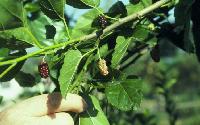Genus: Morus

By Steven D. Glenn, Katherine Gould, Angela Steward
Not peer reviewed
Last Modified 03/04/2013
Nomenclature
Morus L., Sp. Pl. 2: 986. 1753. Gen. Pl. 424. 1754. LECTOTYPE: Morus nigra L. designated by Britton & Brown (1913), or Morus alba designated by Rehder (1949).Key to the species of Morus
1. Leaves glabrous or sparsely pubescent along the larger veins beneath...Morus alba1. Leaves pubescent along secondary and tertiary veins beneath...Morus rubra
List of Morus Species
References to Morus
- Bechtel, A. R. 1921. The floral anatomy of the Urticales. Amer. J. Bot. 8: 386-410.
- Braun, J.; Brooks, G. R. 1987. Box turtles (iTerrapene carolina) as potential agents for seed dispersal. Amer. Midl. Naturalist 117: 312-8.
- Burgess, K. S.; Husband, B. C. 2004. Maternal and paternal contributions to the fitness of hybrids between red and white mulberry (Morus, Moraceae). Amer. J. Bot. 91: 1802-1808.
- Burton, P. J.; Bazzaz, F. A. 1991. Tree seedling emergence on interactive temperature and moisture gradients and in patches of old-field vegetation. Amer. J. Bot. 78(1): 131-49.
- Carr, M. E. 1985. Plant species evaluated for new crop potential. Econ. Bot. 39(3): 336-45.
- Cross, G. L. 1937. The origin and development of the foliage leaves and stipules of Morus alba. Bull. Torrey Bot. Club 64: 145-63.
- Cross, G. L. 1936. The structure of the growing point and the development of the bud scales of Morus alba. Bull. Torrey Bot. Club 63: 451-65.
- Duke, J. A. 1983. The handbook of engery crops.
- Galla, S. J. et.al. 2009. Morus murrayana (Moraceae): a new mulberry from eastern North America. Phytologia 91: 105-116.
- Gray, E. 1990. Evidence of phenotypic plasticity in Mulberry (Morus L.). Castanea 55: 272-81.
- Gray, E.; Call, N. M. 1994. Effects of induced plant injury on leaf lobation in red mulberry (Morus rubra L.). Castanea 59: 167-75.
- Gray, E.; Gray, R. E. 1987. Leaf lobation patterns in mulberry. Castanea 52: 216-24.
- Greive, M. 2000. A modern herbal.
- Gupta, B. K.; Bhakuni, B. S. 1991. Inflorescence behavior of mulberry. Indian J. Forest. 14: 251-2.
- Hans, A. S. 1972. Cytomorphology of arborescent Moraceae. J. Arnold Arbor. 53: 216-25.
- Hardin, J. W. 1981. Atlas of foliar surface features in woody plants, II. Broussonetia, Morus, and Maclura of North America. Bull. Torrey Bot. Club 108: 338-46.
- Krefting, L. W.; Roe, E. I. 1949. The role of some birds and mammals in seed germination. Ecol. Monogr. 19: 269-286.
- McVaugh, R. 1952. Suggested phylogeny of Prunus serotina and other wide ranging phylads in North America. Brittonia 7: 317-346. (And other genera)
- Mitchell, R. S. (eds.) (1988): 1988. Platanaceae through Myricaceae of New York State. New York State Museum Bull. No. 464. The University of the State of New York, the State Education Department, Albany. , 98 pages.
- Nakai, T. 1927. Morus alba and its allies, in the herbaria of Linnaeus, Thunberg and others. J. Arnold Arbor. 8: 234-8.
- Rao, C. K.; Jarvis, C. E. 1986. Lectotypification, taxonomy and nomenclature of Morus rubra, M. tatatica and M. indica (Moraceae). Taxon 35: 705-8.
- Schneider, S. et.al. 1998. Red mulberry: Morus rubra.
- Stapanian, M. A. 1982. A model for fruiting display: seed dispersal by birds for mulberry trees. Ecology 63(5): 1432-43.
- Steen, D. A. et al. et.al. 1995. The big trees of Michigan: 12. Morus rubra L. Michigan Bot. 34: 147-9.
- Sullivan, J. 1993. Morus rubra. ()
- Venkataraman, K. 1972. Wood phenolics in the chemotaxonomy of the Moraceae. Phytochemistry 11: 1571-86.